
5 minute read
Commas Are Important People!
Actually, no. Commas are not people. But they are important, people!
Just ask Sarah Chan, sixth-grade English teacher at The Peck School, a K-8 in Morristown, NJ.
Or perhaps her sixth-grade students—who have often returned to Peck after graduation, thankful that her infamous “Comma Study Sessions” have set them up for writing success in high school and beyond.
Chan is amused by the thought that her simple comma lessons, and the culminating study sessions and test, have made such a large impact.
“I’m shocked you’ve even heard of this test, and more than once!” she exclaimed.
In reality, Chan’s comma unit is a defining moment of the sixth-grade experience—so much so that a recent lunch table conversation covered nothing else, with sixth graders offering punctuation advice to fifth graders with near-gleeful exultation!
We wondered: what’s the story behind the comma?
In an English class known for delving deeply into creativity, commas seem entirely contrary. They’re anti-creative. They’re persnickety. They bring an entirely new—and perhaps even unexpected—challenge to a middle schooler’s brain.
“I think commas challenge a middle schooler to be detail-oriented,” says Chan. "And at this age, speed is the name of the game—they speed from one activity to another, class to class, and they’re multitasking all the time. Being detail-oriented isn’t fully in their nature yet. So this unit forces them to slow down and pay attention.”
At the same time, proper comma usage in writing is an abstract concept. Students need to understand different parts of a sentence and their function to place commas correctly.
While comma usage isn’t new to sixth graders, Chan dives deeper into the hows and whys of the comma than the younger grades, demonstrating usage in both the creative and the practical.
“Addresses really throw them for a loop,” says Chan. “They’re not used to writing letters, and it’s a new way to look at a unit of information.”
At this age, speed is the name of the game—they speed from one activity to another, class to class, and they’re multitasking all the time. Being detail-oriented isn’t fully in their nature yet. So this unit forces them to slow down and pay attention.
This is where Chan has often started her comma lessons, equipping students to look for information within written language, beginning with the concrete before moving to the abstract.
Chan prepares a list of essential comma rules for her students, covering things like proper usage in dates, appositives, prepositional phrases, clauses, and more.
Each rule is a lesson that Chan delivers using creative examples, mnemonic devices, even improv acting! Over the course of about six weeks, students shed the common habit to simply “put commas where they sound right,” and instead begin to see commas as deliberate elements of grammatical construction.
“I’m trying to help them see that there actually is no official 'pause rule',” says Chan.
“They have to be able to recognize the units of information; whether it’s a phrase or a clause, that’s where they’re putting a comma. Not because they happen to be pausing there.”
At the end of the comma unit and before the test, Chan offers several study sessions—and this is where things get exciting.
Students share tips and tricks for remembering the comma rules, catch their errors, share their knowledge, and end up deeply internalizing the huge impact of the humble comma.
“I went to the study sessions every day,” said one of the seventh graders at the aforementioned lunch table. “We told the fifth graders, study a LOT and go to the sessions!”
Ms. Chan's Comma Test: The Peck News Version
Did you know proper comma usage can be a matter of life and death?
Take, for example, the panda who eats, shoots, and leaves. Or when your list of favorite things includes eating your pets and your family! Should you run to safety when your child writes, “is it time to eat mom?”
Ms. Chan let us remix her comma test for Peck News readers. Grab your pen brain and a piece of paper, and see how well you do!
Add commas in the correct places. Email us your answers at thebeacon@peckschool.org!
Pride the mascot of The Peck School has his paws crossed for snow days this year!
Our campus in Morristown New Jersey feels like a home away from home.
The Lost and Found has twenty-five water bottles nineteen cardigans eight pairs of pants three socks and over two dozen jackets that are missing their owners.
If the Redheads earn more Job Well Done tickets their team will catch up to the Downys!
Amidst the excited chatter of students at assembly Mr. Delinsky performed a handstand while balancing a plate cup of coffee and the Woodpecker Cup.
BONUS: How many sentences in the introduction to this test incorrectly use commas?
The Peck School is a K-8, co-ed, independent school in Morristown, NJ. www.peckschool.org
We set the standard for excellence in K-8 education, where academic preparation and character development intersect powerfully in the learning experience. By embedding consideration of others, service, and belonging in all that we do, we are designing an integrated approach to education that develops curious and disciplined learners who positively shape the world. Follow us for more:
Instagram: @thepeckschool
Facebook: facebook.com/peckschool








